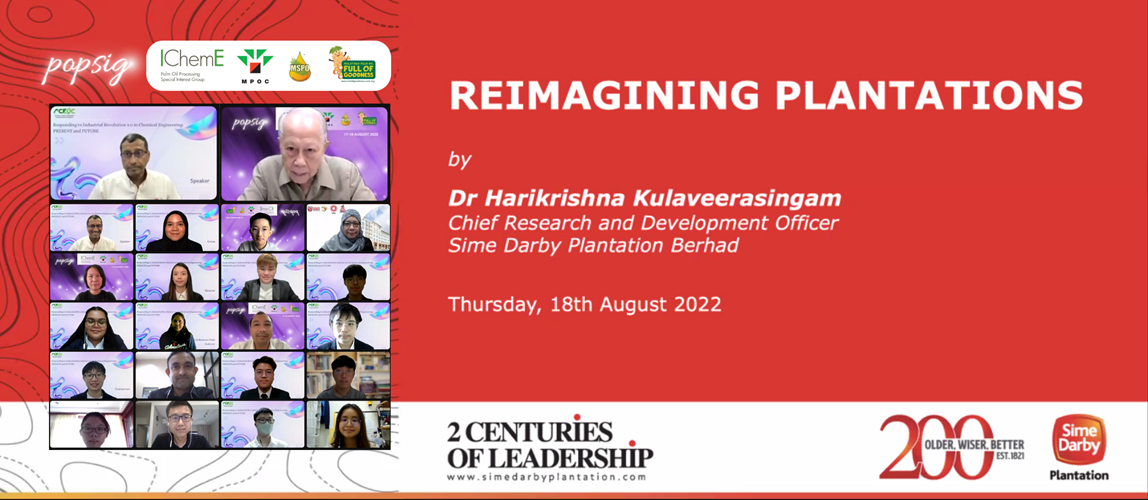Palm Oil Processing
Harikrishna addressed Reimagining Plantations to Gen Z

18th August 2022
Overview
This year, POPSIG had enormous privilege to have Dr Harikrishna Kulaveerasingam, FASc - Chief Research & Development Officer of Sime Darby Plantation Berhad (SDP) - to deliver a keynote speech during online RCEUC conference at Universiti Malaya. The conference was supported by POPSIG.
POPSIG was delighted to welcome the participation of the President of Malaysian Oil Scientists' and Technologists' Association (MOSTA) Yang Berbahagia Academician Tan Sri Emeritus Professor Datuk Dr Augustine S H Ong at Dr Harikrishna’s talk.
Reimagining Plantations
Chapter 1: Challenges in palm oil industry
It is now hardly possible to expand the land areas because of the commitment made not to clear forest and plant on peatlands. Carbon and water footprints reduction need to be considered on further expansion. The materials used need to be climate resilient.
Chapter 2: Journey at SDP
From scientific point of view, Dr Harikrishna believed that the notable achievement at SDP was the genome programme in 2009, and the genome-select planting began in 2016. Digitalisation is still an ongoing commitment at SDP.
Sustainable oil palm growth focuses on two critical areas. One, yield potential that involves technology embedded in seeds. Two, realised yield that addresses high quality. This can be achieved by processing the bunches as soon as possible to support customers’ expectations.
Chapter 3: SDP’s GenomeSelectTM
In 2009, the sequencing was completed. Dr Harikrishna shared that SDP has been breeding crops (oil palm, rubber) for about 80 years. Therefore, it allows the scientists to utilise genomic platform to provide better insights based on the large population that has been collected. It allows to develop improved materials through digital breeding platform; it also develops tools to ensure the products are at high standard. SDP also produces unique IPs and shares publications to drive developments.
The shell of the GenomeSelectTM is thinner, while its mesocarp is a bit bigger. This results in 15% additional oil produced. The commercialised technologies aims to ensure seed purity, to optimise breeding, and to accelerate integration via genomic platform.
Chapter 4: Digitalisation
Advanced intelligent seed system is used to track and trace the seeds, so the customers understand if the seeds come from specific crosses. The seeds are randomly conducted with a subjected DNA test to ensure that they are pure.
Chapter 5: Precision agriculture
One of the challenges at operations was to realise the yield from a commercial standpoint. Although precision agriculture (PA) improves productivity and reduces costs, less than 20% of the agricultural land utilises digital technologies globally. SMART platform has been used to monitor and manage data.
PA unit (PAU) develops satellite and drone imaging for geolocation services. It enables to virtualise water management (flood) for improving drainage system. It is important to deliver the crops to the mills efficiently especially in the case of high yield productions, as the recovered yield and crops freshness are the keys.
Chapter 6: Crop recovery
SDP is working with Universiti Putra Malaysia (UPM) on a developing machine with the performance of picking bunches at 30 sec per bunch. It is expected to deliver high productivity and be simple.
Chapter 7: Field upkeep & nursery management
Dr Harikrishna showed the new machanised fertiliser machine with low manuring cost, improved labour usage and faster application.
Chapter 8: Milling & refining
SDP is progressing towards a Unified Control Centre. On industrial automation, the company wants to create smart factory to fully connect the parameters. Predictive maintenance involves software to control everything in the R&D mill, of which this system will be rolled out into the operations. IoT in agriculture will connect operations at the mills with the refineries.
Chapter 9: Midstream value chain
Mill is equipped with command and control centres with automation and sensors to allow it to be efficient. Carbon dioxide released can be recycled back by algae farming to reduce carbon footprint. Zero discharge can be achieved where treated water can be used as boiler water.
Chapter 10: Way forward at SDP
Dr Harikrishna shared that it is important to conduct proof of concept (POC) trials under commercial conditions to demonstrate the effectiveness and values of technologies. In the immediate term, SDP was targeting at easily implementable solutions, such as drone spraying, PA tools and reduced manual operations. On medium term, they aimed at semi-autonomous machines for improved productivity. For long-term plan, SDP targeted to deploy fully autonomous mechanisation for all operations, i.e. full plantation 4.0 deployment.
Dr Harikrishna underlined that “data is the new currency and data analytics is the new bank”. Data is being collected via digital tools and it is the key to become more efficient and effective at operations.
About Dr Harikrishna Kulaveerasingam
Dr Harikrishna is the Chief Research and Development Officer at SDP. He completed his first degree (BSc) in Plant Sciences from the University of London (Wye College), and completed his PhD in Plant Developmental and Molecular Biology at the University of Leicester. He has over 30 years' post-graduate experience in biotechnology and in 2012 he was inducted into the Malaysian Academy of Science as a fellow.
In May 2009, Sime Darby announced that it has successfully sequenced, assembled, and annotated the oil palm genome exclusively using second generation sequencing technology – making it the world’s first company to achieve this scientific break-through using this technology, an effort spearheaded by Dr Harikrishna.
Acknowledgement
POPSIG gratefully appreciates the support provided by Malaysian Palm Oil Council and the contributions of Dr Harikrishna Kulaveerasingam (SDP) at this event.
Back to group news